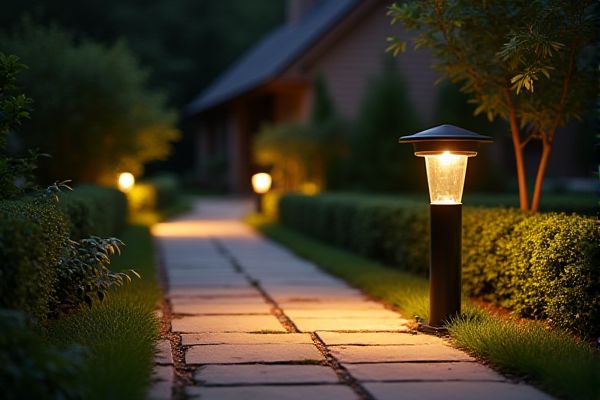
Pathway lights provide low-level illumination ideal for guiding your steps along garden paths with subtle, spaced lighting, while bollard lights offer stronger, more visible lighting with a post-like structure that can also serve as decorative elements in landscapes. Discover which lighting option best suits your outdoor space by reading the rest of the article.
Table of Comparison
| Feature | Pathway Light | Bollard Light |
|---|---|---|
| Design | Low profile, close to ground | Short but taller post-style fixture |
| Purpose | Illuminate walkways and garden paths | Mark boundaries and driveways |
| Light Distribution | Soft, downward lighting | 360-degree ambient lighting |
| Installation Height | Typically 6-12 inches from ground | Generally 24-48 inches tall |
| Material | Metal, plastic, or glass options | Durable metals and weather-resistant finishes |
| Use Case | Decorative and pathway safety | Security and boundary definition |
| Power Source | Solar, low-voltage electric, or LED | Low-voltage electric or LED |
| Cost | Generally lower-priced | Moderate to higher cost |
Pathway Light vs Bollard Light: Key Differences
Pathway lights are low-level fixtures designed to illuminate walkways and garden paths subtly, providing guidance without overwhelming brightness. Bollard lights stand taller, typically between 2 to 4 feet, offering more substantial illumination and serving as both functional lighting and decorative outdoor elements. Choosing between pathway and bollard lighting depends on your outdoor space size, lighting needs, and the desired ambiance, with pathway lights enhancing subtle visibility and bollards providing a stronger presence and illumination.
Understanding Pathway Lighting
Pathway lighting is designed to illuminate walkways for safety and aesthetic appeal, with pathway lights typically mounted low to the ground and featuring broad, diffuse light to cover pedestrian areas. Bollard lights, a subset of pathway lighting, stand taller--usually between 2 to 4 feet--and provide focused, downward illumination that enhances visibility while reducing light pollution. Selecting between pathway lights and bollard lights depends on factors like light intensity, design compatibility, and the desired ambiance for outdoor spaces.
What Are Bollard Lights?
Bollard lights are short, sturdy outdoor lighting fixtures typically mounted on posts between 2 to 4 feet high, designed to illuminate pathways, driveways, and gardens for both safety and aesthetic appeal. Unlike pathway lights, bollard lights provide broader, more uniform light distribution and often serve as architectural features in landscape design. Your choice of bollard lighting enhances visibility and guides movement while adding a modern or classic touch to outdoor spaces.
Design and Aesthetic Comparison
Pathway lights typically feature low-profile designs with subtle stakes that blend seamlessly into garden beds, creating a soft, understated ambiance. Bollard lights stand taller with cylindrical structures, offering a more pronounced presence and a modern, architectural appeal. Your choice depends on whether you prefer discreet illumination or a bold visual statement to enhance outdoor spaces.
Installation Methods and Requirements
Pathway lights typically feature simple spike or stake installation methods that allow for easy placement directly into the ground without extensive groundwork. Bollard lights require more robust installation, often involving a concrete footing or base to ensure stability and durability in high-traffic areas. Both lighting types demand appropriate wiring and waterproofing standards to meet outdoor electrical safety regulations and ensure long-term functionality.
Energy Efficiency: Pathway vs Bollard Options
Pathway lights typically consume less energy due to their smaller size and lower wattage LED bulbs, making them more energy-efficient for illuminating walkways and garden paths. Bollard lights, while providing more substantial lighting coverage and durability, often require higher power levels to achieve their brightness, which can increase energy usage. Choosing LED technology for both options enhances energy efficiency, but pathway lights remain preferable for minimized energy consumption in low-traffic outdoor areas.
Best Applications for Pathway Lights
Pathway lights are best suited for illuminating walkways, garden paths, and driveway edges, providing low-level lighting that enhances safety and aesthetic appeal. Unlike bollard lights, pathway lights are typically smaller, stake-mounted fixtures ideal for guiding foot traffic without overpowering the surrounding landscape. Your outdoor space benefits from pathway lights as they create a subtle ambiance while clearly defining routes for pedestrian use.
Ideal Uses for Bollard Lights
Bollard lights are ideal for illuminating walkways, driveways, and garden paths, providing both safety and aesthetic appeal with their sturdy, post-like structure. These lights offer higher visibility due to their elevated design, making them perfect for guiding pedestrians in larger outdoor spaces such as parks or commercial areas. Your outdoor lighting setup benefits from bollard lights by enhancing security while maintaining an elegant landscape ambiance.
Cost Considerations and Budgeting
Pathway lights generally have a lower upfront cost and simpler installation compared to bollard lights, making them ideal for budget-conscious projects. Bollard lights, while more expensive, offer greater durability and enhanced illumination, potentially reducing maintenance costs over time. Budgeting should factor in long-term benefits such as energy efficiency, lifespan, and installation complexity when choosing between pathway and bollard lighting options.
Choosing the Right Outdoor Lighting Solution
Pathway lights provide low-level illumination ideal for marking walkways and enhancing safety, while bollard lights offer higher, more robust lighting that defines garden edges and driveways. Your choice depends on the desired brightness and design impact; pathway lights create subtle guidance, whereas bollard lights serve as prominent landscape features. Consider the installation area and lighting purpose to select the best outdoor lighting solution for security and aesthetic appeal.
 homyna.com
homyna.com